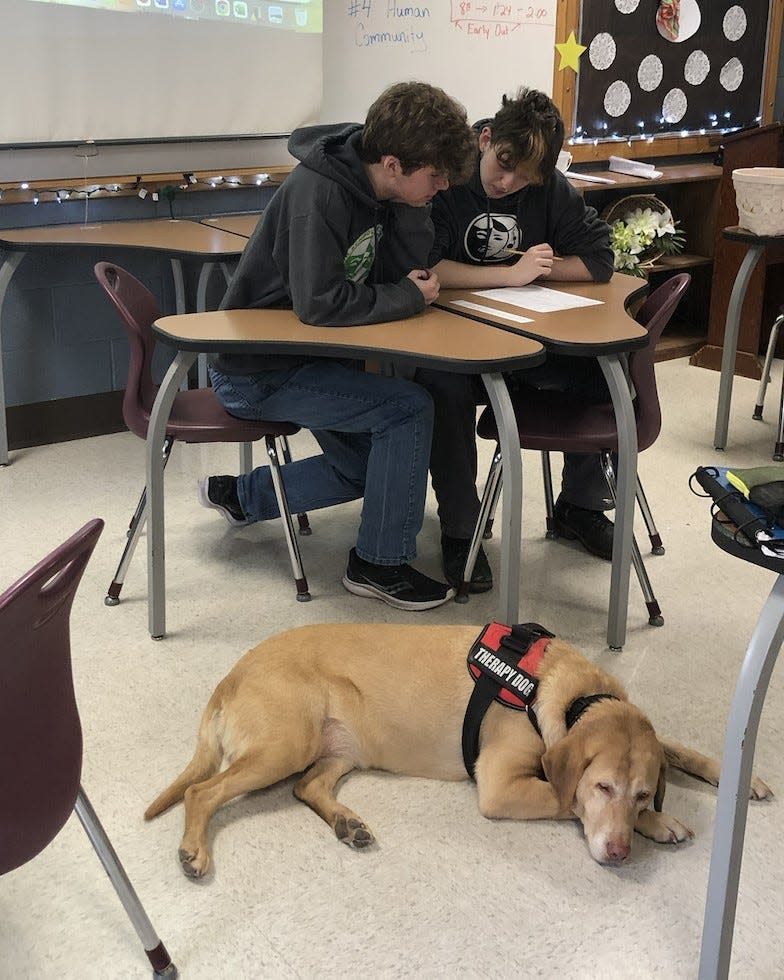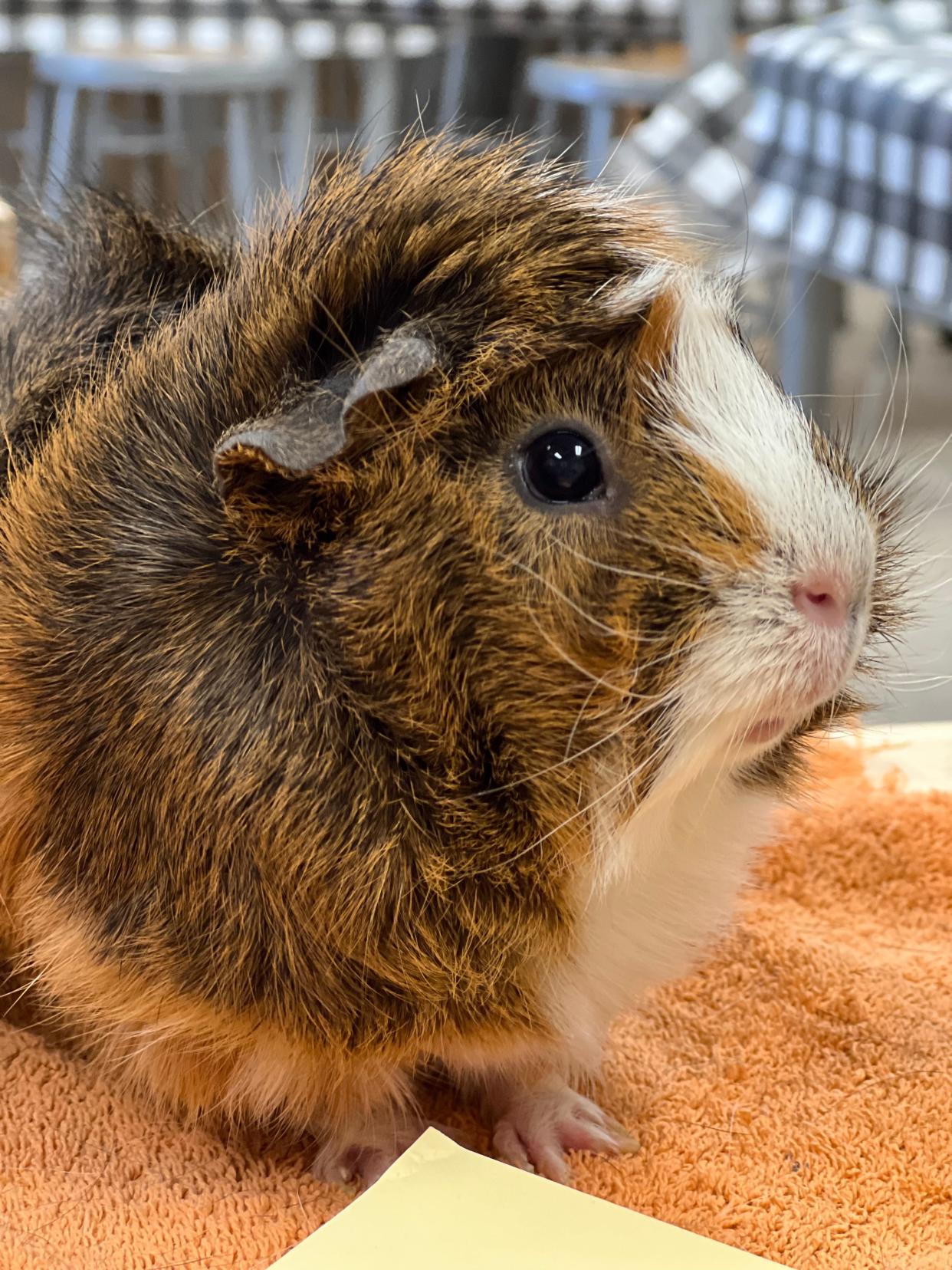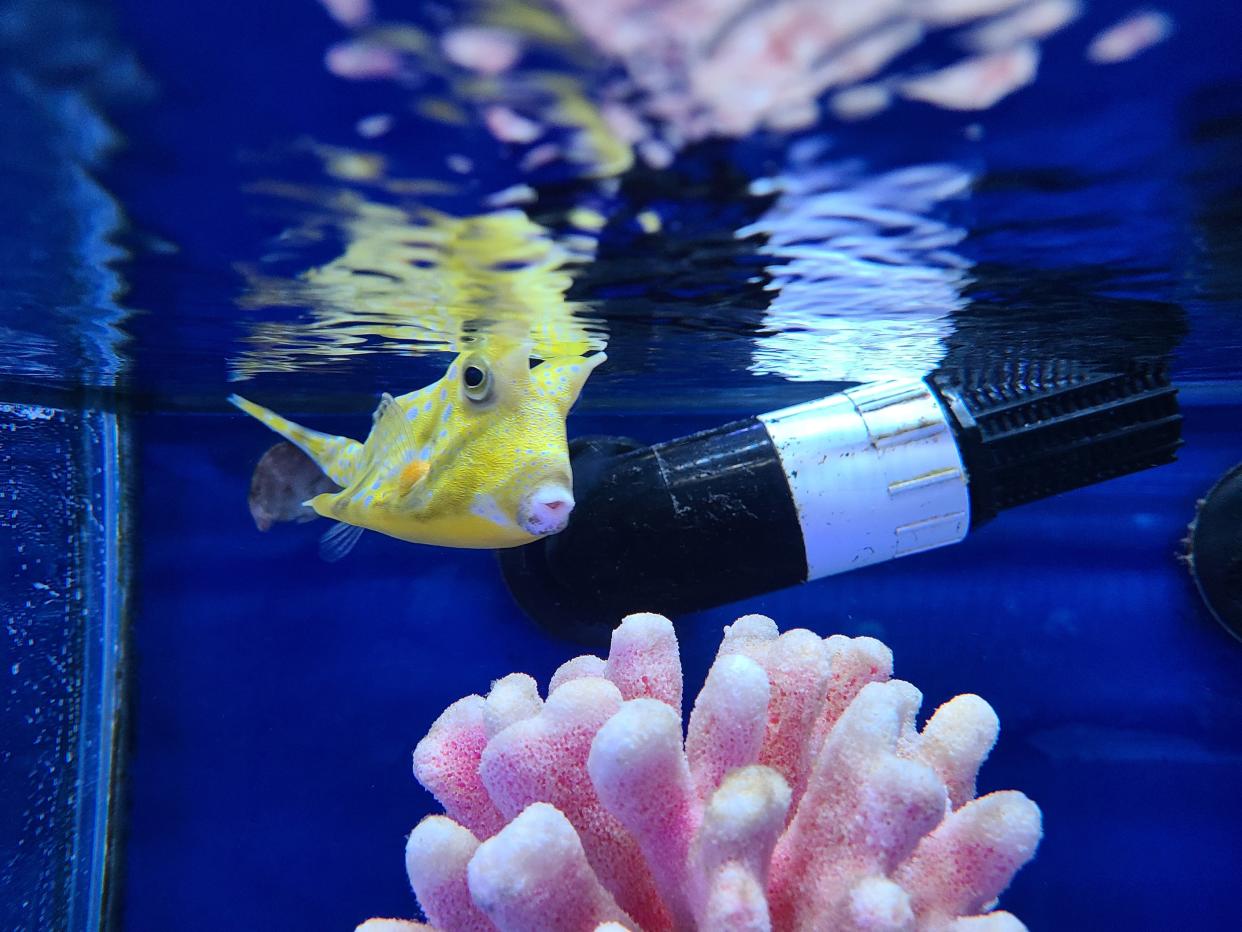Teacher's pet: How dogs, lizards and hamsters are helping students feel at ease
As a child, Ann Ott sought solace in Tippy, her family's dog, after she was sexually abused.
As she worked through the trauma, Ott would hug Tippy and cry almost every night.
"She slept with me and licked my tears," she said.

Ott worked hard to overcome the abuse, but never forgot Tippy. In 2018, life took an unexpected and sad turn when she lost her father, father-in-law, and her shih tzu-Lhasa apso mix, Tipper, who was named in honor of Tippy.
The multiple losses left the Iowa high school teacher looking for a purpose.
It was then that Ott, a social studies teacher with the Osage Community School District, decided she wanted to train the family's outdoor hunting dog, Millie, to be a therapy dog and take her to school.
"One of the things that got me through (the abuse) was our dog," Ott said, "and I love that dog so much and what I wouldn't have given to have a dog in (school)."
Though some doubted the yellow Labrador retriever had the right temperament for the work, a fully trained Millie joined Ott at school in January 2021.
Ott is not alone in wanting to bring the healing power of animals into the classroom.
In schools across the country, teachers and administrators have brought dogs, rabbits, frogs, hamsters and the occasional chinchilla to class in the hopes of teaching students about empathy, responsibility and how to be good wildlife stewards.

Experts have long said animals in the classroom can be a calming presence for kids.
Ott saw this firsthand when a middle school student stopped by her classroom to pet 9-year-old Millie. The girl told the long-time teacher she only came to school that day to see the dog.
"I’m so glad you are here," Ott recalls telling the girl as she choked back tears, "she wants to see you, too!"

"That validated everything," she said. "I know (having Millie) has helped at least one student on one day. It has been one of the most rewarding things I’ve done in my nearly 31 years in education."
Things are not always so heavy with Millie, Ott said. The dog had to be taught not to steal students' water bottles. Another time, Millie got away and crashed a girls basketball practice.
"I was just going down to make some copies," Ott said with a laugh, "and before I know it, she's running into the girls basketball practice trying to catch all these balls and they just thought it was so much fun."
Keep reading to learn more about how Iowa's teachers' pets are helping students learn, heal and laugh.
Hamster in need turns art room into refuge

Nicole Smith never expected her Riceville Community School District art room to become a shelter for small and exotic animals.
The first animal to take up residence in Smith's classroom was Henry, a hamster who needed to be rehomed.
Henry instantly became a draw for her high school students.
"He used to sit in their pockets while they did art – you know, in their sweatshirt pockets – or they would take a towel and make him a little burrow and he'd sit on the table and shove his cheeks full of food," Smith said.
After Henry died, her students begged for another class pet.

Almost a decade later, Smith's art room has served as a refuge for chinchillas, birds, an iguana and even fire-belly toads – all of which needed a home.
The chinchillas – who were supposedly both female – surprised Smith and her students with a baby chinchilla, called a kit.
At the moment, the art room's inhabitants are Georgia the rabbit, named in honor of Georgia O'Keefe; and two guinea pigs, Bernadette and Hannah.

For all the care Smith and her students give the classroom critters, the animals give back so much more.
"(Students) have so much going on that having the animals, even on the table, allows them to take a breath and refocus, and just calm their minds enough to even create something," Smith said.
Digger, the comeback pup

Van Meter Community School District's therapy dog Digger is a real Cinderella story.
As a young dog, he flunked out of service dog school, said his owner Danette Cox, a first grade teacher at Van Meter Elementary School. It was Cox's daughter who saw his potential and decided to train Digger to be a therapy dog.
When the English yellow Lab's training was complete, Cox began bringing him to work at Van Meter Community School District. The school even gave Digger his own Van Meter employee badge.

Over the past seven years, Digger has become a companion for nervous first-time students, a comforting presence for children, and the one who picks up stray pencils off of Cox's classroom floor.
"He's used as a reward for kids that have some struggling behaviors," said Cox. "If they've made their goal, then a lot of times they'll come down and get Digger as part of their reward."
Students never know whether they will see Digger walking to class with a child, playing tug-of-war on the playground or napping under a table.

"Everybody knows him," Cox said. "He makes his way around school."
Having pets like Digger in the classroom can teach students a lot about acceptance and unconditional love, she said.
"They're accepted no matter what," Cox said of how animals react to children. "It doesn't matter how you look or what your disability is."
Des Moines schools' Central Campus is a little fishy

Students and staff are not likely to find a furry animal to cuddle in Greg Barord's Central Campus marine biology classroom.
But people still come to his room to relax and watch the inhabitants of the program's many tanks.
"We'll see (or) hear the door close and different colleagues and teachers come in,” Barord said. “The lab, I think, is for everyone, which is what we want because it provides so much excitement sometimes.”
When he came to Des Moines Public Schools 10 years ago, Barord focused on having students take care of the marine life and did not think much about the serene environment the tanks created in the building.
"As I continued teaching and caring for the animals, (I learned) at the same time you're kind of caring for the students,” he said.
Now he sends students who are having a bad day to clean a tank or simply have them observe the fish.

Despite the calming environment and daily interactions, Barord stresses the classroom's lobsters, octopus, cowfish, stingrays and other sea life are not pets. Students are even asked to refrain from naming any of the thousands of organisms.
Sometimes bonds form by accident.
Recent Ankeny High School graduate Addie Hartmann began spending a lot of time with the class cowfish after she began to study its behavior.
"It's developed facial recognition with me specifically because I used to feed that tank every day," Hartmann said. "And when I come closer you can see signs of excitement" including spitting water.
Her time in Barord's class inspired her to study marine biology in college.
Barord wants people to know there is value to having different types of animals in schools. Animals in the classroom also can help facilitate hard but important discussions about humanely letting them go.
"Depending on the species, it just gives very different talking points of what it means for the animal ... and then we always try to apply it to ocean marine conservation stuff in the wild," Barord said.
Stanley stealing hearts and pancakes

It is often Stanley's smiling face greeting Virgil Grissom Elementary School students as they come through the door each morning.
When a child is reluctant to come inside, Stanley's owner, Principal Kyle Harris, offers them the chance to walk the 6-year-old goldendoodle to class.
After morning drop-off, the principal and Stanley visit classrooms in the North Scott Community School District building and sometimes sit in on reading lessons.
"Stanley, he loves being with all the kids," Harris said.
The students love him as well.
Just before the end of the school year, Harris had a second grade student in the office crying because she missed her mother. She calmed down while petting Stanley and talking to Harris.
"Sometimes what he's very helpful with in those situations is taking their mind off something that maybe is bugging them (and) allowing them to kind of open up," he said.
The pooch has even been known to attend the occasional parent-teacher meeting when a calming presence is needed.
"He kind of senses who is in need of a little love," Harris said.
Stanley is not always the best-behaved boy. Once, while touring a classroom at breakfast time, he reached over and stealthily stole a pancake off a student's tray. This and other antics have earned Stanley the nickname "the vacuum cleaner."

Despite four years on the job, he cannot shake the moniker.
"His favorite room to visit (is the preschool) because he always knows when there's crumbs on the floor," Harris said. "So we try to avoid any rooms during snack time but sometimes he'll find something on the floor and clean it up for us."
Rocky teaches empathy and responsibility

Lincoln Elementary teacher Connie Ryan’s classroom is not exactly a zoo, but it does have zookeepers who care for Rocky the bearded dragon.
Ryan, who teaches fourth grade language arts and science, has been bringing Rocky to school in Osage for six years. Each week, one of her homeroom students is chosen to be a zookeeper and care for the lizard. This means they handle his feedings, basic terrarium maintenance, and giving him the occasional bath.
“Often students request to stay in at a recess with a friend to complete his care tasks,” Ryan said.
She describes Rocky as a “homebody” who monitors hallway traffic from his enclosure. He does enjoy walking around the classroom and perching on people’s shoulders like a parrot.
When younger students stop by Ryan’s classroom, they are sometimes given the opportunity to hold the bearded dragon and feed him a mealworm.
“His laidback presence has a calming (effect) for these individuals, as they have been taught that lots of noise, sudden movements, and rough handling are not what he prefers,” Ryan said. “We discuss the importance of practicing self-control and having consideration for other’s needs and safety. This kind of empathy is difficult for some kids to have towards peers and adults, but with Rocky they see it as a sense of duty, privilege, and friendship.”
Samantha Hernandez covers education for the Des Moines Register, part of the USA TODAY Network. Reach her at svhernandez@gannett.com. Follow her on Twitter at @svhernandez or Facebook at facebook.com/svhernandezreporter.
This article originally appeared on Des Moines Register: Pets in classrooms help calm students and teach empathy responsibility
